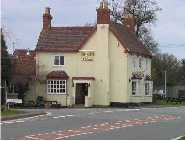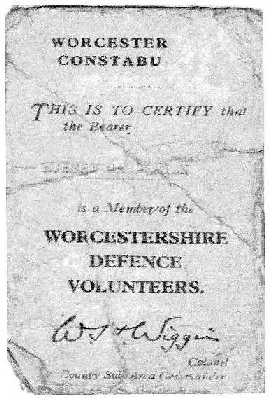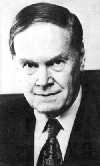THE
COOKHILL PLATOON
"D"
Coy., 9th WORCESTERSHIRE (REDDITCH) HOME GUARD
 Egbert
Ganderton, now in his
90s, was known to
his Home Guard colleagues
as "Gandy"; he signed on immediately the LDV
was formed in May 1940 and was sworn in at "The Nevill
Arms" Public House, New End, Astwood Bank, where
thanks to the landlady, Mrs Jordan, the Home Guard were
allowed to use a room upstairs as their headquarters.
Here they would meet two or three times a week and also
enjoy some after hours drinking. Egbert's well handled
original Certificate of Membership, signed by Col. W.H.
Wiggin in his capacity of County Sub Area Commander, is
shown to the right.
Egbert
Ganderton, now in his
90s, was known to
his Home Guard colleagues
as "Gandy"; he signed on immediately the LDV
was formed in May 1940 and was sworn in at "The Nevill
Arms" Public House, New End, Astwood Bank, where
thanks to the landlady, Mrs Jordan, the Home Guard were
allowed to use a room upstairs as their headquarters.
Here they would meet two or three times a week and also
enjoy some after hours drinking. Egbert's well handled
original Certificate of Membership, signed by Col. W.H.
Wiggin in his capacity of County Sub Area Commander, is
shown to the right.
The
LDV was quickly renamed on Churchill orders as the Home
Guard. Local training, including drill, was carried out
in a field opposite the Nevill. Egbert describes how in
the beginning the Cookhill Home Guard were so poorly equipped,
having no uniforms and very little in weapons. One piece
of weaponry they were issued with was a piece of cheese
wire to use as a garrote - they were expected to creep
up behind a German sentry and put it around his neck,
awaiting the consequences. Alternatively they could use
a hatpin and push it in behind the enemy's ear!
Egbert
makes the point that it was compulsory to attend parades.
Discipline in the Battalion was strict. He recalls that
one evening when two elderly Home Guard failed to make
the appropriate challenge when approached by a senior
officer, they were subsequently dismissed and had to hand
their kit in.
It was later in 1940 that
Cookhill along with other companies in the Redditch Battalion
were issued with the American P 17 rifle (17 denoting
the year of manufacture), an added complication being
that the ammunition was of .300 calibre. The standard
British Army rifle was of .303 calibre, so ammunition for the two rifles
was incompatible. He remembers that he kept his rifle
with 5 rounds of live ammunition at home.
rifle was of .303 calibre, so ammunition for the two rifles
was incompatible. He remembers that he kept his rifle
with 5 rounds of live ammunition at home.
The live rifle firing
was carried out down the Hacking, but the ricocheting
bullets were traveling as far as Arrow Lane, Cookhill!!
Due to this fact the rifle range was moved to the Inkberrow
range, which was where the Millennium Garden is now. Again
there was the problem of ricocheting bullets necessitating
the range being moved to Norton Barracks, Worcester.
The field next to the
Baptist Chapel, known as Chapel Ground, was used for bayonet
drill. This entailed charging at straw filled sacks hung
on some upright structure like a post.
The initial role of the
local Home Guard was to carry out night patrols around
the village, with School Lane and Arrow Road referred
to as part of the patrol route. Another task was to man
a roadblock, which consisted of a pole placed horizontal,
on top of three tubs filled with soil, and barbed wire
in front. This would be erected across the A442, some
200yds from the top of Oak Tree Lane towards Evesham (opposite
the old Bakery in Cookhill). Should an enemy tank approach
this roadblock it was intended to attack it by climbing
on to it and dropping a hand grenade into the hatch. He
thought that it was very unlikely that the barrier would
stop a tank! Apparently no defence post or trenches were
constructed at the roadblock to protect the Home Guard
personnel, they being expected to hide close-by on either
side of the road until an attack was made.
Egbert does recall an
incident one night, when, at Arrow Crossroads, Cookhill,
he and Cyril Buggins were on duty and stopped an Army
staff car, which had an officer and ATS girl driver in
it. The officer asked for directions to Hartlebury but
was refused this information until the officer produced
the appropriate pass to show him. The officer protested,
at which Egbert asked Cyril to stand back and load his
rifle in preparation to shoot if the officer drove off.
The ATS girl suggested that perhaps the officer ought
to show his pass, which he reluctantly did. From this
it could be seen that the officer was in fact a Colonel.
He had apparently already been asked to show his identity
three times that particular night and was becoming somewhat
annoyed with the Home Guard. Egbert confirms that he would
have ordered Cyril to shoot if the officer had driven
off without showing his pass.
On several occasions Cookhill
was required to send H.G to guard the Reynolds Tube Factory
on Studley Rd., Redditch. He well remembers spending one
uncomfortable night sleeping on straw mattresses, and
was still be expected to be at work next morning.
One of the more exciting
events was when the Home Guard was called out after a
parachute was discovered in a tree at Cookhill Priory.
With rifles loaded the Home Guard went out to look for
the would-be parachutist, and an extensive search was
carried out but it was to no avail. It transpired that
this was part of German planning at that time, to try
and unsettle the defence, making them think an invasion
was underway. It did have its benefits as a number of
wartime brides in and around Cookhill took advantage of
this event and utilized the silk of the parachute for
their wedding dresses!
Early in the war the RAF
took over the field next to the Baptist Chapel, Cookhill,
land belonging to Mr. Lionel Waldron at the Forge Farm.
His son Ken recalls a high ranking R.A.F. officer, complete
with an armed escort, arriving and informing his father
that they required this field and would pay him a rent
for it. It was made quite clear to him the nature of this
proposal and he realized that he was left with no other
option than to agree.
The RAF personnel to man
this establishment were billeted in the farmhouse as well
as various houses on the village. The footpath to the
Baptist Chapel was diverted to the west side of the hedge
for the duration of the war. A Guard hut was located just
inside the field, and armed sentries patrolled the site
to prevent any unauthorized access. Cookhill Home Guard
shared the responsibility with the R.A.F. to guard this
faculty both day and night. The night guard comprised
two RAF airmen and two Home Guards.
Articulated lorries, loaded
with specialized radio equipment, were positioned in the
field. Strong brick walls were built to protect them from
bomb blast. The author has talked to the widow of one
of the men who was stationed at this site. He was subject
to the 30-year secrecy law, which as we know stopped him
from discussing anything in which he was involved, and
so his wife knew very little of what he did. She was however
very familiar with the name of Professor R.V.
 Jones
(seen left). He was a brilliant war time scientist, who
was one of the people credited in discovering why the
German air force (the Luftwaffe) were able to bomb so
accurately. They used a series of radio signals, which
were transmitted from the Continent to Britain to guide
them on to their target. By establishing the frequency
of these signals, it was possible to jam, or "bend
them", thus confusing the German pilots as to the
exact location of the target. The present day opinion
is that the Baptist Field site was one of these beam-bending
stations run by 80 Wing RAF. The R.A.F personnel were
able to inform the Home Guard when a raid was going to
take place; this fact bears out that they were picking
up the German transmissions immediately that they occurred.
Jones
(seen left). He was a brilliant war time scientist, who
was one of the people credited in discovering why the
German air force (the Luftwaffe) were able to bomb so
accurately. They used a series of radio signals, which
were transmitted from the Continent to Britain to guide
them on to their target. By establishing the frequency
of these signals, it was possible to jam, or "bend
them", thus confusing the German pilots as to the
exact location of the target. The present day opinion
is that the Baptist Field site was one of these beam-bending
stations run by 80 Wing RAF. The R.A.F personnel were
able to inform the Home Guard when a raid was going to
take place; this fact bears out that they were picking
up the German transmissions immediately that they occurred.
Egbert received training
on using the 80/36 hand grenade. On return from this course
he was promoted to the rank of corporal and was responsible
for training his fellow H.G. colleagues in the instructions
for the priming & handling of hand grenades. This
could be a dangerous procedure for premature explosions
were not unknown. Grenade training locally took place
at the site of the old rifle range in Pitcher Oak Wood,
Redditch, On one occasion he remembers one of his colleagues
who was very nervous hanging on to the grenade too long
and receiving a reprimand from Capt Seal, the Battalion's
Weapons Officer. Later most of this training was moved
to Norton Barracks, Worcester. Whereas most H.G. kept
5 rounds of live rifle ammunition at home, hand grenades
were only issued on training days.
One of the more humorous
incidents which Egbert recalls involved a wicker chair
in the Guard Hut at the Chapel Ground. A stove was used
to keep the hut warm. He thinks they must have fallen
asleep because the stove set fire to the chair which was
then thrown outside into the field. There was an air raid
taking place at the time. Alf Briney rushed off to get
water from a nearby well. The rope broke at the well and
so, without water, the flames had to be extinguished by
stamping on them.
Training exercises were
usually held at monthly intervals and mainly at the weekend.
Some were local, and others farther afield. Battle training
was held at Hampton Lovett, Nr. Droitwich, Worcestershire
when live ammunition was used. Egbert remembers one particular
exercise when they had to advance through a spinney along
a stream, reach a hollow in the ground, fire 5 rounds
at a target, being bombed by thunder flashes, and having
to keep their heads down as the Canadian army were firing
tracer bullets over their heads.
Egbert admits that in
the earlier days the H.G. were poorly armed and trained,
but as more equipment, including light artillery, became
available, training exercises stepped up, stricter discipline
was enforced and he felt that the Redditch Battalion which
was some 2000 strong would have given a good account of
itself if called upon.
©
M. Johnson 2006
Several
of the images on this page come via the courtesy of Mr.
Ganderton. The image of the rifle comes from the personal
collection of Mick Wilks to whom acknowledgement is given.
Mr. Wilks is the co-author of "The Mercian Maquis" - see Links and Further
Reading page.
Please do not forget to
contact Mike Johnson via this website if you can add to the Battalion's
story. A condensed version of the above article and other
local information about Cookhill can be seen here.
(You will leave this site).